Temazepam
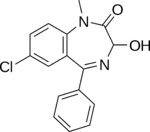 | |
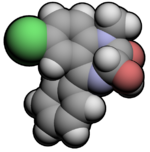 | |
| Systematic (IUPAC) name | |
|---|---|
|
7-Chloro- 1,3-dihydro- 3-hydroxy- 1-methyl- 5-phenyl- 1,4-benzodiazepin- 2-one | |
| Clinical data | |
| Pregnancy category | |
| Routes of administration |
Therapeutic: Oral Recreational Abuse: Intravenous (IV), Intramuscular (IM), Insufflated, Sprinkled in ethanol, smoked |
| Legal status | |
| Legal status |
|
| Pharmacokinetic data | |
| Bioavailability | 96% |
| Metabolism | Hepatic |
| Biological half-life | 8–20 hours |
| Excretion | Renal |
| Identifiers | |
| CAS Number | 846-50-4 |
| ATC code | N05CD07 (WHO) |
| PubChem | CID 5391 |
| DrugBank | APRD00676 |
| ChemSpider | 5198 |
| Chemical data | |
| Formula | C16H13ClN2O2 |
| Molar mass | 300.7 g/mol[[Script error: No such module "String".]] |
| Script error: No such module "collapsible list". | |
| (verify) | |
Temazepam (trade name Restoril, among others) is an intermediate-acting 3-hydroxy benzodiazepine. It is generally prescribed for the short-term treatment of sleeplessness in patients who have difficulty maintaining sleep. In addition, temazepam has anxiolytic (anti-anxiety), anticonvulsant, and skeletal muscle relaxant properties.[1][2][3]
Contents
History
Temazepam was first synthesized in 1964, but it first came into use in 1969 when its ability to counter insomnia was realised.[4] By the late 1980s, temazepam was one of the most popular and widely prescribed hypnotics on the market and it became one of the most widely prescribed drugs.
Indications
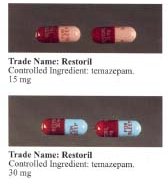
Temazepam is a hypnotic agent. In sleep laboratory studies, temazepam significantly decreased the number of nightly awakenings[5] but has the drawback of distorting the normal sleep pattern.[6]
Temazepam is officially indicated for severe insomnia and other severe or disabling sleep disorders. The prescribing guidelines in the UK limit the prescribing of hypnotics to two-to-four weeks due to concerns of tolerance and dependence.[7]
The United States Air Force uses temazepam as one of the hypnotics approved as "no-go pills" to help aviators and special duty personnel sleep in support of mission readiness. "Ground tests" are required prior to authorization being issued to use the medication in an operational situation. [1]
Contraindications
Use of temazepam should be avoided, when possible, in individuals with the following conditions:
- Ataxia (gross lack of coordination of muscle movements)
- Severe hypoventilation
- Acute narrow-angle glaucoma
- Severe hepatic deficiencies (hepatitis and liver cirrhosis decrease elimination by a factor of 2)
- Severe renal deficiencies (e.g. patients on dialysis)
- Sleep apnea[8]
- Severe depression, particularly when accompanied by suicidal tendencies
- Acute intoxication with alcohol, narcotics, or other psychoactive substances
- Myasthenia gravis (autoimmune disorder causing muscle weakness)
- Hypersensitivity or allergy to any drug in the benzodiazepine class
Special caution needed
Temazepam should not be used in pregnancy, as it may cause harm to the fetus. The safety and effectiveness of temazepam has not been established in children; therefore temazepam should generally not be given to individuals under 18 years of age, and should not be used at all in children under 6 months old. Benzodiazepines also require special caution if used in the elderly, alcohol or drug-dependent individuals and individuals with comorbid psychiatric disorders.[9]
Temazepam, similar to other benzodiazepines and nonbenzodiazepine hypnotic drugs causes impairments in body balance and standing steadiness in individuals who wake up at night or the next morning. Falls and hip fractures are frequently reported. The combination with alcohol increases these impairments. Partial, but incomplete tolerance develops to these impairments.[10] The smallest possible effective dose should be used in elderly or very ill patients, as there is a risk of apnea and/or cardiac arrest. This risk is increased when temazepam is given concomitantly with other drugs that depress the central nervous system.[11]
Patients at a high risk for abuse and dependence
Because benzodiazepines can be abused and lead to dependence, their use should be avoided in people in certain particularly high risk groups. High risk groups include people with a history of alcohol or drug abuse or dependence, emotionally unstable patients, people with severe personality disorders (such as Borderline Personality Disorder). If temazepam is indeed prescribed to people in these groups, they should generally be monitored very closely for signs of abuse and development of dependence.[7]
Adverse effects
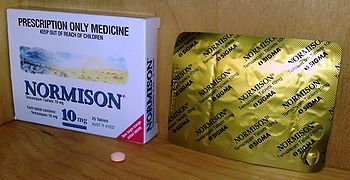
Common
Side effects typical of hypnotic benzodiazepines are related to CNS depression, and include somnolence, dizziness, fatigue, ataxia, headache, lethargy, impairment of memory and learning, increased reaction time and impairment of motor functions (including coordination problems),[12] slurred speech, decreased physical performance, numbed emotions, reduced alertness, muscle weakness, blurred vision (in higher doses), and inattention. Euphoria was rarely reported with the use of temazepam. According to the FDA, temazepam had an incidence of euphoria of 1.5%, much more rarely reported than headaches and diarrhea.[11] Anterograde amnesia may also develop, as may respiratory depression in higher doses.
Less common
Hyperhydrosis, hypotension, burning eyes, changes in libido, hallucinations, faintness, nystagmus, vomiting, pruritus, gastrointestinal disturbances, nightmares, palpitation and paradoxical reactions including restlessness, aggression, violence, overstimulation and agitation have been reported, but are rare (less than 0.5%).
Before taking temazepam, one should ensure that at least 8 hours are available to dedicate to sleep. Failing to do so can increase the side effects of the drug.
The use of this drug in combination with alcohol potentiates the side effects, and can lead to toxicity and death.
Though rare, residual "hangover" effects after nighttime administration of temazepam such as sleepiness, impaired psychomotor and cognitive functions may persist into the next day, which may impair the ability of users to drive safely or may increase the risks of falls and hip fractures.[13]
Tolerance and physical dependence
Tolerance
Chronic or excessive use of temazepam may cause drug tolerance, which can develop rapidly,[14] so this drug is therefore not recommended for long-term use.[11][15] In 1979 the Institute of Medicine (USA) and the National Institute on Drug Abuse stated that most hypnotics lose their sleep-inducing properties after about 3 to 14 days.[16] In use longer than 1–2 weeks, tolerance will frequently develop towards the ability of temazepam to maintain sleep, so that the drug loses effectiveness.[17] Some studies have observed tolerance to temazepam after as little as one week's use.[18] Another study examined the short-term effects of the accumulation of temazepam over 7 days in elderly inpatients, and found that little tolerance developed during the accumulation of the drug.[19] Other studies examined the use of temazepam over six days and saw no evidence of tolerance.[20][21] A study in 11 young male subjects showed that significant tolerance occurs to temazepam's thermoregulatory effects and sleep inducing properties after 1 week of use of 30 mg temazepam. Body temperature is well correlated with the sleep inducing or insomnia promoting properties of drugs.[22]
In one study the drug sensitivity of people who had used temazepam for 1–20 years was no different from that of controls.[23] An additional study, in which at least one of the authors is employed by multiple drug companies, examined the efficacy of temazepam treatment on chronic insomnia over three months and saw no drug tolerance, with the authors even suggesting that the drug might become more effective over time.[24][25][26]
Establishing continued efficacy beyond a few weeks can be complicated by the difficulty in distinguishing between the return of the original insomnia complaint and withdrawal or rebound related insomnia. Sleep EEG studies on hypnotic benzodiazepines show that tolerance tends to occur completely after one to four weeks with sleep EEG returning to pretreatment levels. The paper concluded that due to concerns about long term use both toxicity and tolerance and dependence as well as controversy over long term efficacy that wise prescribers should restrict benzodiazepines to a few weeks and avoid continuing prescriptions for months or years.[27] A review of the literature found that non-pharmacological treatment options were a more effective treatment option for insomnia due to their sustained improvements in sleep quality.[28]
Physical dependence
Temazepam like other benzodiazepine drugs can cause physical dependence and addiction. Withdrawal from temazepam or other benzodiazepines after regular use often leads to a benzodiazepine withdrawal syndrome, which resembles symptoms during alcohol and barbiturate withdrawal. The higher the dose and the longer the drug is taken for, the greater the risk of experiencing unpleasant withdrawal symptoms. Withdrawal symptoms can also occur from standard dosages and after short term use. Abrupt withdrawal from therapeutic doses of temazepam after long term use may result in a severe benzodiazepine withdrawal syndrome. Gradual and careful reduction of the dosage, preferably with a long-acting benzodiazepine with long half life active metabolites such as chlordiazepoxide or diazepam is recommended, to prevent severe withdrawal syndromes from developing. Other hypnotic benzodiazepines are not recommended.[29] A study in rats found that temazepam is cross tolerant with barbiturates and is able to effectively substitute for barbiturates and suppress barbiturate withdrawal signs.[30] There are rare reports in the medical literature of psychotic states developing after abrupt withdrawal from benzodiazepines, even from therapeutic doses.[31] Antipsychotics increase the severity of benzodiazepine withdrawal effects with an increase in the intensity and severity of convulsions.[32] Patients who were treated in the hospital with temazepam or nitrazepam have continued taking these after leaving the hospital. It was recommended that hypnotics in the hospital be limited to 5 nights use only, to avoid the development of withdrawal symptoms like insomnia.[33]
Medical research issues
The Journal of Clinical Sleep Medicine published a paper expressing concerns about benzodiazepine receptor agonist drugs, the benzodiazepines and the Z-drugs that are used as hypnotics in humans. The paper cites a systematic review of the medical literature concerning insomnia medications and states that almost all trials of sleep disorders and drugs are sponsored by the pharmaceutical industry while this is not the case in general medicine or psychiatry. It cites another study that "found that the odds ratio for finding results favorable to industry in industry-sponsored trials was 3.6 times as high as in non–industry-sponsored studies". Issues discussed regarding industry-sponsored studies include: comparison of a drug to a placebo, but not to an alternative treatment; unpublished studies with unfavorable outcomes; and trials organized around a placebo baseline followed by drug treatment, but not counterbalanced with parallel-placebo-controlled studies. Quoting a 1979 report that there was then, too, little research into hypnotics that was independent of the drug manufacturers, the authors conclude that "the public desperately needs an equipoised assessment of hypnotic benefits and risks" and that the NIH and VA should provide leadership to that end.[34]
Pharmacology
It is a white, crystalline substance, is very slightly soluble in water and sparingly soluble in alcohol. The main pharmacological action of temazepam is to increase the effect of the neurotransmitter GABA (gamma-aminobutyric acid) at the GABAA receptor. This causes sedation, motor-impairment, ataxia, anxiolysis, anticonvulsant effect, muscle relaxation and reinforcing effect.[35] As a premedication before surgery, temazepam decreased cortisol in elderly patients.[36] In rats, temazepam triggered the release of vasopressin into paraventricular nucleus of the hypothalamus and decreased the release of ACTH under stress.[37]
Pharmacokinetics
Oral administration of 15 to 45 mg temazepam in man resulted in rapid absorption with significant blood levels achieved in less than 30 minutes and peak levels at 2 to 3 hours.[38] In a single and multiple dose absorption, distribution, metabolism, and excretion (ADME) study, using tritium (3H) labelled drug, temazepam was well absorbed and found to have minimal (8%) first pass drug metabolism. There were no active metabolites formed and the only significant metabolite present in blood was the O-conjugate. The unchanged drug was 96% bound to plasma proteins. The blood level decline of the parent drug was biphasic with the short half-life ranging from 0.4-0.6 hours and the terminal half-life from 3.5–18.4 hours (mean 8.8 hours), depending on the study population and method of determination.[39]
Temazepam has very good bioavailability with almost 100% being absorbed from the gut. The drug is metabolized through conjugation and demethylation prior to excretion. Most of the drug is excreted in the urine, with about 20% appearing in the feces. The major metabolite was the O-conjugate of temazepam (90%); the O-conjugate of N-desmethyl temazepam was a minor metabolite (7%).[40]
Interactions
As other benzodiazepines, temazepam produces additive CNS depressant effects when co-administered with other medications which themselves produce CNS depression, such as barbiturates, alcohol,[41] opiates, tricyclic antidepressants, non-selective MAO inhibitors, phenothiazines and other antipsychotics, skeletal muscle relaxants, antihistamines and anaesthetics. Administration of theophylline or aminophylline has been shown to reduce the sedative effects of temazepam and other benzodiazepines.
Unlike many benzodiazepines, pharmacokinetic interactions involving the P450 system have not been observed with temazepam. Temazepam shows no significant interaction with CYP3A4 inhibitors (e.g. itraconazole, erythromycin).[42] Oral contraceptives may decrease the effectiveness of temazepam and speed up its elimination half life.[43]
Overdose
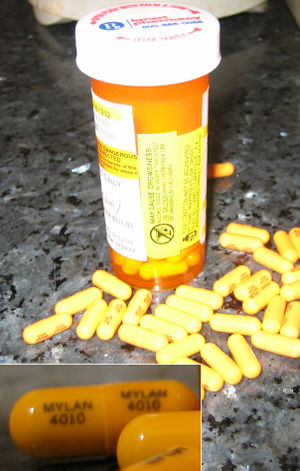
Overdosage of temazepam results in increasing CNS effects, including:
- Somnolence (difficulty staying awake)
- Mental confusion
- Respiratory depression
- Hypotension
- Impaired motor functions
- Impaired or absent reflexes
- Impaired coordination
- Impaired balance
- Dizziness
- Coma
- Death
Temazepam had the highest rate of drug intoxication, including overdose, among the common benzodiazepines in cases with and without combination with alcohol in a study of 1985.[44] Temazepam and nitrazepam were the two benzodiazepines most commonly detected in overdose-related deaths in an Australian study of drug deaths.[45] A 1993 British study found temazepam to have the highest number of deaths per million prescriptions among medications commonly prescribed in the 1980s (11.9, versus 5.9 for benzodiazepines overall, taken with or without alcohol).[46] A 1995 Australian study of patients admitted to hospital after benzodiazepine overdose corroborated these results, and found temazepam overdose much more likely to lead to coma in comparison to other benzodiazepines (odds ratio 1.86). The authors note that several factors—such as differences in potency, receptor affinity, and rate of absorption between benzodiazepines—could explain this higher toxicity.[44]
Although benzodiazepines have a high therapeutic index, temazepam is one of the more dangerous of this group of drugs.
The combination of alcohol and temazepam makes death by alcohol poisoning more likely.[47]
Recreational use
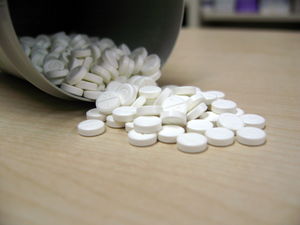
Temazepam is a drug with the potential for misuse. Drug misuse is defined as taking the drug to achieve a high, or continuing to take the drug in the long term against medical advice.[48]
North America
In North America, temazepam misuse is not widespread. Other benzodiazepines are more commonly prescribed for insomnia. In the United States, temazepam is the fifth most prescribed benzodiazepine. Individuals abusing benzodiazepines obtain the drug by getting prescriptions from several doctors, forging prescriptions, or buying diverted pharmaceutical products on the illicit market.[49] North America never had a serious problem with temazepam misuse, but is becoming increasingly vulnerable to the illicit trade of temazepam.[50]
Australia
Temazepam accounts for most benzodiazepine sought by forgery of prescriptions and through pharmacy burglary in Victoria.[51] Due to intravenous abuse, the Australian government decided to put it under a more restrictive schedule than it previously was,[52] and since March 2004 temazepam capsules have been withdrawn from the Australian market.[53][54] Benzodiazepines are commonly detected by Customs at different ports and airports, arriving by mail, also found occasionally in the baggage of air passengers, mostly small or medium quantities (up to 200–300 tablets) for personal use. From 2003 to 2006 customs detected approximately 500 illegal importations of benzodiazepines per year, most frequently diazepam. Quantities varied from single tablets to 2,000 tablets.[55][56]
United Kingdom
In 1987, Temazepam was the most widely-abused legal prescription drug in the United Kingdom. The use of benzodiazepines by street drug abusers was part of a polydrug abuse pattern, but many of those entering treatment facilities were declaring temazepam as their main drug of abuse. Temazepam was the most commonly used benzodiazepine in a study, published 1994, of injecting drug users in seven cities and had been injected from preparations of capsules, tablets and syrup.[57] The increase in use of heroin, often mixed with other drugs, which most often included temazepam, diazepam and alcohol, was a major factor in the increase in drug related deaths in Glasgow and Edinburgh 1990-1992.[58] Temazepam use was particularly associated with violent or disorderly behaviours and contact with the police in a 1997 study of young single homeless people in Scotland.[59]
Street terms
Street terms for temazepam include king kong pills (formerly referred to barbiturates, now more commonly refers to temazepam), jellies, jelly, Edinburgh eccies, tams, terms, mazzies, temazies, tammies, temmies, beans, eggs, green eggs, wobbly eggs, knockouts, hardball, norries, oranges (common term in Australia and New Zealand), rugby balls, ruggers, terminators, red and blue, no-gos, blackout, green devils, drunk pills, brainwash, mind erasers, tem-tem's (combined with buprenorphine), mommy's big helper, vitamin T, big T, TZ, and others.[60][61]
Availability
Temazepam is available in English-speaking countries under the following brand names:
- Euhypnos
- Normison
- Norkotral
- Remestan
- Restoril
- Temaze
- Temtabs
- Tenox
Legal status
Temazepam is currently a Schedule III drug under the international Convention on Psychotropic Substances of 1971.[62]
In the United Kingdom, temazepam is a Class C controlled drug under the Misuse of Drugs Act 1971 (Schedule 3 under the Misuse of Drugs Regulations 2001).[63] If prescribed privately (not on the NHS), Temazepam is available only by a special controlled drug prescription form (FP10PCD) and pharmacies are obligated to follow special procedures for storage and dispensing.[64] Additionally, all manufacturers in the UK have replaced the gel-capsules with solid tablets.
In the USA, temazepam is a Schedule IV drug and is only available by prescription. Specially coded prescriptions may be required in certain States.
In Canada, temazepam is a Schedule IV controlled substance requiring a registered doctors prescription.
In Ireland, temazepam is a Schedule 3 controlled substance with strict restrictions.[65]
In Portugal, temazepam is a Schedule IV controlled drug under Decree-Law 15/93.[66]
In the Netherlands, temazepam is available for prescription as 10–20 mg tablets and capsules. Formulations of temazepam containing less than 20 mg are included in List 2 of the Opium Law, while formulations containing 20 mg or more of the drug (along with the gel-capsules) are a List 1 substance of the Opium Law and thus subject to more stringent regulation.
In Singapore, temazepam is a Class A controlled drug (Schedule I), making it illegal to possess and requiring a private prescription from a licensed physician in order to be dispensed.
In Thailand, temazepam is a Schedule II controlled drug under the Psychotropic Substances Act. Possession and distribution of the drug is illegal.
In Sweden, temazepam is classed as a "narcotic" drug listed as both a List II (Schedule II) which denotes that it is a drug with limited medicinal use and a high risk of addiction, and it's also listed as a List V (Schedule V) substance which denotes that the drug is prohibited in Sweden under the Narcotics Drugs Act (1968).[67] Temazepam is banned in Sweden and possession and distribution of even small amounts is punishable by a prison sentence and a fine.
In Norway, temazepam is not available as a prescription drug. It is regulated as a Class A substance under Norway's Narcotics Act.
In Australia, prescription is restricted as a Schedule 4 controlled drug.[68] It is used primarily for the treatment of severe insomnia that has not responded to other treatments.
In Slovenia, it is regulated as a Group II (Schedule 2) controlled substance under The Production and Trade in Illicit Drugs Act.[69][70]
In South Africa, temazepam is a Schedule 6 drug, requiring a special prescription, and is restricted to 10–20 mg doses.
In Hong Kong, temazepam is regulated under Schedule 1 of Hong Kong's Chapter 134 Dangerous Drugs Ordinance. Temazepam can only be used legally by health professionals and for university research purposes. The substance can be given by pharmacists under a prescription. Anyone who supplies the substance without prescription can be fined $10000 (HKD). The penalty for trafficking or manufacturing the substance is a $5,000,000 (HKD) fine and life imprisonment. Possession of the substance for consumption without license from the Department of Health is illegal with a $1,000,000 (HKD) fine and/or 7 years of jail time.[71]
See also
- Long term effects of benzodiazepines
- Benzodiazepine withdrawal syndrome
- Benzodiazepine dependence
- Benzodiazepines
- Flunitrazepam
- Nitrazepam
- Nimetazepam
References
Cite error: Invalid <references> tag;
parameter "group" is allowed only.
<references />, or <references group="..." />External links
- Professor Heather Ashton, Benzodiazepines; How they work and How to Withdraw
- Rx-List - Temazepam
- Inchem - Temazepam
- Medline Plus (US Government supported website) entry for Temazepam
- Active Ingredients information
- ↑ Lua error in package.lua at line 80: module 'Module:Citation/CS1/Suggestions' not found.
- ↑ Lua error in package.lua at line 80: module 'Module:Citation/CS1/Suggestions' not found.
- ↑ Fuccella LM (1979). "Bioavailability of temazepam in soft gelatin capsules" (PDF). Br J Clin Pharmacol. 8 (1): 31S–5S. PMC 1429631 Freely accessible. PMID 41540.
- ↑ Lua error in package.lua at line 80: module 'Module:Citation/CS1/Suggestions' not found.
- ↑ Bixler EO, Kales A, Soldatos CR, Scharf MB, Kales JD (1978). "Effectiveness of temazepam with short-intermediate-, and long-term use: sleep laboratory evaluation". J Clin Pharmacol. 18 (2–3): 110–8. PMID 342551.
The effectiveness of 30 mg temazepam (SaH 47-603) for inducing and maintaining sleep was evaluated in the sleep laboratory in six insomniac subjects....
- ↑ Ferrillo, F; Balestra, V; Carta, F; Nuvoli, G; Pintus, C; Rosadini, G (1984). "Comparison between the central effects of camazepam and temazepam. Computerized analysis of sleep recordings". Neuropsychobiology. 11 (1): 72–6. PMID 6146112.
The effects of acute administration per os of 30 mg camazepam and the same dose of temazepam, were compared with placebo in 8 young male volunteers....
- ↑ 7.0 7.1 BNF (2008). "TEMAZEPAM". British National Formulary. Retrieved 17 August 2008.
- ↑ "Temazepam Oral". Web MD Professional. Medscape. Retrieved 2010-08-22.
- ↑ Lua error in package.lua at line 80: module 'Module:Citation/CS1/Suggestions' not found.
- ↑ Lua error in package.lua at line 80: module 'Module:Citation/CS1/Suggestions' not found.
- ↑ 11.0 11.1 11.2 Lua error in package.lua at line 80: module 'Module:Citation/CS1/Suggestions' not found.
- ↑ Lua error in package.lua at line 80: module 'Module:Citation/CS1/Suggestions' not found.
- ↑ Vermeeren A (2004). "Residual effects of hypnotics: epidemiology and clinical implications". CNS Drugs. 18 (5): 297–328. doi:10.2165/00023210-200418050-00003. PMID 15089115.
- ↑ Kales A (1990). "Quazepam: hypnotic efficacy and side effects". Pharmacotherapy. 1 (10): 1–10. PMID 1969151.
- ↑ MedlinePlus
- ↑ Lua error in package.lua at line 80: module 'Module:Citation/CS1/Suggestions' not found.
- ↑ Lua error in package.lua at line 80: module 'Module:Citation/CS1/Suggestions' not found.
- ↑ Roehrs T, Kribbs N, Zorick F, Roth T (1982). "Hypnotic residual effects of benzodiazepines with repeated administration". Sleep. 9 (2): 309–16. PMID 2905824.
- ↑ Lua error in package.lua at line 80: module 'Module:Citation/CS1/Suggestions' not found.
- ↑ Lua error in package.lua at line 80: module 'Module:Citation/CS1/Suggestions' not found.
- ↑ Tedeschi G, Griffiths AN, Smith AT, Richens A (1 October 1985). "The effect of repeated doses of temazepam and nitrazepam on human psychomotor performance". Br J Clin Pharmacol. 20 (4): 361–7. PMC 1400899 Freely accessible. PMID 2866784.
- ↑ Lua error in package.lua at line 80: module 'Module:Citation/CS1/Suggestions' not found.
- ↑ Lua error in package.lua at line 80: module 'Module:Citation/CS1/Suggestions' not found.
- ↑ Lua error in package.lua at line 80: module 'Module:Citation/CS1/Suggestions' not found.
- ↑ "Conflict of interest disclosures" (PDF). American Academy of Sleep Medicine and the Sleep Research Society. Retrieved 17 August 2008.
- ↑ Lua error in package.lua at line 80: module 'Module:Citation/CS1/Suggestions' not found.
- ↑ Lua error in package.lua at line 80: module 'Module:Citation/CS1/Suggestions' not found.
- ↑ Kirkwood CK (1999). "Management of insomnia". J Am Pharm Assoc (Wash). 39 (5): 688–96; quiz 713–4. PMID 10533351.
- ↑ Lua error in package.lua at line 80: module 'Module:Citation/CS1/Suggestions' not found.
- ↑ Lua error in package.lua at line 80: module 'Module:Citation/CS1/Suggestions' not found.
- ↑ Terao T, Tani Y (1988). "[Two cases of psychotic state following normal-dose benzodiazepine withdrawal]". J. Uoeh (in Japanese). 10 (3): 337–40. PMID 2902678.
- ↑ Tagashira E, Hiramori T, Urano T, Nakao K, Yanaura S (1981). "Enhancement of drug withdrawal convulsion by combinations of phenobarbital and antipsychotic agents". Jpn. J. Pharmacol. 31 (5): 689–99. doi:10.1254/jjp.31.689. PMID 6118452.
- ↑ Lua error in package.lua at line 80: module 'Module:Citation/CS1/Suggestions' not found.
- ↑ Kripke DF (December 15, 2007). "Who should sponsor sleep disorders pharmaceutical trials?". J Clin Sleep Med. 3 (7): 671–3. PMC 2556906 Freely accessible. PMID 18198797.
NIH or VA sponsorship of major hypnotic trials is needed to more carefully study potential adverse effects of hypnotics such as daytime impairment, infection, cancer, and death and the resultant balance of benefits and risks.
- ↑ Oelschläger H (July 4, 1989). "[Chemical and pharmacologic aspects of benzodiazepines]". Schweiz Rundsch Med Prax. 78 (27–28): 766–72. PMID 2570451.
- ↑ Lua error in package.lua at line 80: module 'Module:Citation/CS1/Suggestions' not found.
- ↑ Welt T, Engelmann M, Renner U; et al. (2006). "Temazepam triggers the release of vasopressin into the rat hypothalamic paraventricular nucleus: novel insight into benzodiazepine action on hypothalamic-pituitary-adrenocortical system activity during stress". Neuropsychopharmacology. 31 (12): 2573–9. doi:10.1038/sj.npp.1301006. PMID 16395302.
- ↑ http://www.rxmed.com/b.main/b2.pharmaceutical/b2.1.monographs/CPS-%20Monographs/CPS-%20(General%20Monographs-%20R)/RESTORIL.html
- ↑ Müller FO, Van Dyk M, Hundt HK; et al. (1987). "Pharmacokinetics of temazepam after day-time and night-time oral administration". Eur. J. Clin. Pharmacol. 33 (2): 211–4. doi:10.1007/BF00544571. PMID 2891534.
- ↑ Schwarz HJ (August 1, 1979). "Pharmacokinetics and metabolism of temazepam in man and several animal species" (PDF). British journal of clinical pharmacology. 23 (29): 23S–29S. PMC 1429628 Freely accessible. PMID 41539.
- ↑ Lua error in package.lua at line 80: module 'Module:Citation/CS1/Suggestions' not found.
- ↑ Ahonen J, Olkkola KT, Neuvonen PJ (1996). "Lack of effect of antimycotic itraconazole on the pharmacokinetics or pharmacodynamics of temazepam". Ther Drug Monit. 18 (2): 124–7. doi:10.1097/00007691-199604000-00003. PMID 8721273.
- ↑ Lua error in package.lua at line 80: module 'Module:Citation/CS1/Suggestions' not found.
- ↑ 44.0 44.1 Buckley NA, Dawson AH, Whyte IM, O'Connell DL. (1995). "[Relative toxicity of benzodiazepines in overdose.]". BMJ. 310 (6974): 219–21. PMC 2548618 Freely accessible. PMID 7866122.
- ↑ Lua error in package.lua at line 80: module 'Module:Citation/CS1/Suggestions' not found.
- ↑ Serfaty M, Masterton G (1993). "Fatal poisonings attributed to benzodiazepines in Britain during the 1980s". Br J Psychiatry. 163: 386–93. doi:10.1192/bjp.163.3.386. PMID 8104653.
- ↑ Lua error in package.lua at line 80: module 'Module:Citation/CS1/Suggestions' not found.
- ↑ Griffiths RR, Johnson MW (2005). "Relative abuse liability of hypnotic drugs: a conceptual framework and algorithm for differentiating among compounds". J Clin Psychiatry. 66 Suppl 9: 31–41. PMID 16336040.
- ↑ BENZODIAZEPINES (Street Names: Benzos, Downers, Nerve Pills, Tranks)
- ↑ Bureau for International Narcotics and Law Enforcement Affairs (BINLEA), 2006.
- ↑ "Injecting Temazepam: The facts — Temazepam Injection and Diversion". Victorian Government Health Information. 29 March 2007. Retrieved 2007-11-25.
- ↑ "Access to sedative drug restricted". AAP General News (Australia). 13 January 2002. Retrieved 2008-02-18.
- ↑ Lua error in package.lua at line 80: module 'Module:Citation/CS1/Suggestions' not found.
- ↑ Lua error in package.lua at line 80: module 'Module:Citation/CS1/Suggestions' not found.
- ↑ Mouzos, J., Smith, L. and Hind, N, 2006. Drug Use Monitoring in Australia (DUMA): 2005 annual report on drug use among police detainees, Research and Public Policy Series No. 70. Australian Institute of Criminology, Canberra.
- ↑ Stafford, J., Degenhardt, L., Black, E., Bruno, R., Buckingham, K., Fetherston, J., Jenkinson, R., Kinner, S., Newman, J. and Weekley, J., 2006. Australian drug trends 2005: Findings from the Illicit Drug Reporting System (IDRS). National Drug and Alcohol Research Centre, Sydney.
- ↑ Ashton H (2002). "Benzodiazepine Abuse". Drugs and Dependence. London & New York: Harwood Academic Publishers. Retrieved 2007-11-25.
- ↑ Hammersley R, Cassidy MT, Oliver J (1995). "Drugs associated with drug-related deaths in Edinburgh and Glasgow, November 1990 to October 1992". Addiction. 90 (7): 959–65. doi:10.1046/j.1360-0443.1995.9079598.x. PMID 7663317.
- ↑ Hammersley R, Pearl S (1997). "Temazepam Misuse, Violence and Disorder". Addict Res Theory. 5 (3): 213–22. doi:10.3109/16066359709005262.
- ↑ "Temazepam abuse and slang terms". North Eastern Health Board.
- ↑ "Erowid Drug Street Terms". Erowid.
- ↑ "Green List—List of psychotropic substances under international control" (PDF). International Narcotics Control Board. 23rd edition, August 2003. Retrieved 2007-11-25. Check date values in:
|date=(help) - ↑ "List of drugs currently controlled under the misuse of drugs legislation" (PDF). UK Government Home Office. 2009-01-28. Retrieved 2009-05-27.
- ↑ http://www.patient.co.uk/printer.asp?doc=40024943
- ↑ "Misuse Of Drugs (Amendment) Regulations". Irish Statute Book. Office of the Attorney General. 1993.
- ↑ "Decreto-Lei n.º 15/93, de 22 de Janeiro: Regime jurídico do tráfico e consumo de estupefacientes e psicotrópicos" (PDF) (in Portuguese). Infarmed. Retrieved 2009-09-29.
- ↑ ____284.aspx Narkotikaklassade läkemedel, Läkemedelsverket
- ↑ "[[Standard for the Uniform Scheduling of Drugs and Poisons|Poisons Standard]]" (PDF). Therapeutic Goods Administration. August 14, 2008. p. 143. Retrieved 2009-06-20. URL–wikilink conflict (help)
- ↑ http://candidates2003.emcdda.europa.eu/download/si/ZPPA-angl.doc
- ↑ http://eldd.emcdda.europa.eu/html.cfm/index5622EN.html
- ↑ "Bilingual Laws Information System" (English). The Government of the Hong Kong Special Administrative Region of the People's Republic of China.
- Pages using duplicate arguments in template calls
- Pages with script errors
- Infobox drug tracked parameters
- Articles without EBI source
- Articles without KEGG source
- Articles without InChI source
- Articles without UNII source
- Drugboxes which contain changes to watched fields
- Anticonvulsants
- Anxiolytics
- Benzodiazepines
- Hypnotics
- Muscle relaxants
- Sedatives
- Organochlorides
- Lactams
- Alcohols
- Pages with broken file links
- CS1 maint: Multiple names: authors list
- CS1 maint: Unrecognized language
- CS1 maint: Explicit use of et al.
- CS1 errors: dates
- CS1 errors: URL–wikilink conflict